I enjoy walking with others interested in the outdoors so I sometimes join the free bird walks at the Riverwood Conservancy in Mississauga led by Luc Fazio and Dan Salisbury. They’ve shown us many great birds close-up including Yellow and Black-billed Cuckoos and Mourning Warblers. With so many curious eyes, we also find other wildlife. On today’s mid-September march, Trishia Kluge found a lovely rusty brown thumb-sized caterpillar with five large white “eyes” on its sides clinging to a grape vine along the Red Deer trail.
Very Large Caterpillars Are Often Sphinx Moths in Disguise
The caterpillar we saw was so large and its markings were so vivid, I knew it would be fairly easy to id. I was sure I’d seen photos of it but I couldn’t remember what kind it was.
Most of the other caterpillars I’ve seen that were thumb-sized were young Sphinx moths. (Monarch caterpillars also get long but not this fat.) I wasn’t sure if this was a Sphinx, though, due to its colouring and the lack of a tail “horn.” Many of the sphinxes I’ve seen in the past like the Waved Sphinx my child found have a distinctive long horn.
Pandora Sphinx Moth Caterpillars Lose Their Horn
A quick flip through the useful book Photo Field Guide to Some Caterpillars of Southern Ontario by Ian Carmichael and Ann Vance, led me to id the caterpillar as a Pandora Sphinx. The book explains that though the young instars of the caterpillar have a long tail, it is absent in the later stages.
Apparently, these caterpillars can also be green with the same five large oval white eye spots with a dark dot in the center.
Is This Huge Brown Caterpillar Ready to Pupate? What Do Pandora Sphinx Caterpillars Eat?
When I saw the size of the caterpillar, I mentioned to some other bird watchers that I thought it was ready to form a pupa. In fact, I mistakenly thought it was on the grapevine looking for a good spot to transform, not to eat.
The Field Guide pointed out I’m wrong: Pandora Sphinx caterpillars eat grape leaves and Virginia Creeper leaves as well as some viburnums.
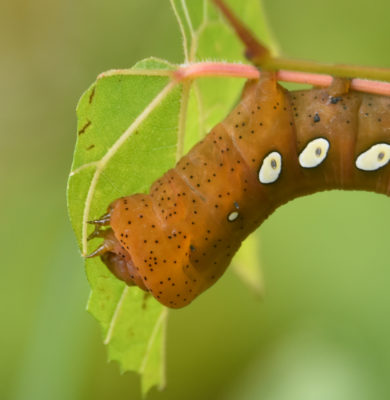
This isn’t some hideous tentacle mouth thing–these caterpillars can pull their head and first segments back into the third segment for protection, kind of like hiding part of your face in a turtleneck sweater. The pointy bits are just the front legs.
That reminded me–the Waved Sphinx caterpillar we found dug quickly into the ground under a tree, presumably to pupate and over-winter.
I went online to find out where Pandora Sphinx moths transform. The Butterflies and Moths of North America site says they “pupate in shallow chambers in the soil.” Presumably, they dig out these chambers themselves although the website doesn’t say. So if this caterpillar is ready to form its pupa it will move down to the ground first, not hang off a grape vine.
The Mystery of the Unnamed Sphinx Moth Caterpillar at Riverwood in Mississauga
This isn’t the first Sphinx moth caterpillar found during a bird walk at Riverwood this year. In mid-June, I found a large green caterpillar also on a grape vine at the Chappell House end of the Green Butterfly trail. It didn’t look full grown but it was already several centimetres long (over two inches.) I couldn’t figure out what kind of sphinx it was; now I’m very curious.
What Green Sphinx Moth Caterpillar Has a Green Horn and Small Black Dots Divided In Half By a White Line?
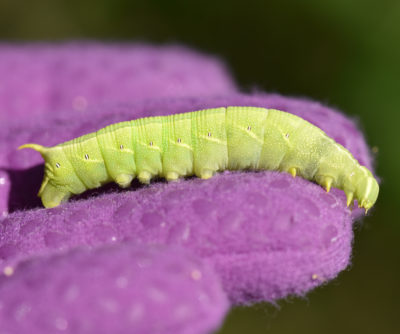
I don’t normally pick up insects but I couldn’t get a clear look at this one so I accidentally had it walk onto me while I was holding the leaf to try for a better photo.
Even in younger stages, Pandora Sphinx caterpillars seem to have the large oval spots on their sides, so my spring caterpillar was not a Pandora even though it was also on a grape vine.
My green Sphinx had small black dots or spiracles divided down the center by a white line. They don’t look like “eyes” nor do they have rings of black, white or red like many Sphinxes.
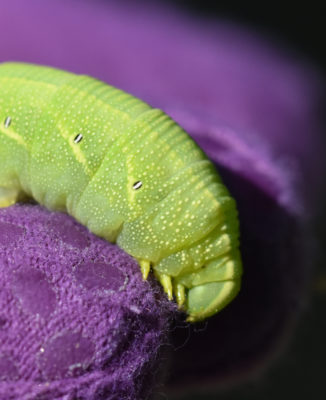
You may be able to see the faint yellow stripes and black and white spiracles in this photo of the head end of the caterpillar.
It didn’t look like a Virginia Creeper Sphinx either, which has sort of fingers or stripes of white along the sides.
After looking at a zillion (ok 8) types of Sphinx moth caterpillars’ photos online on the BugGuide.net website, I decided it was probably a Deidamia inscriptum also called a Lettered Sphinx Moth.
Both Pandora and Lettered Sphinx Moths Feed on Grape Vines
The Lettered Sphinx moth caterpillar has an odd corrugated cardboard texture along its back. So did the one I found.
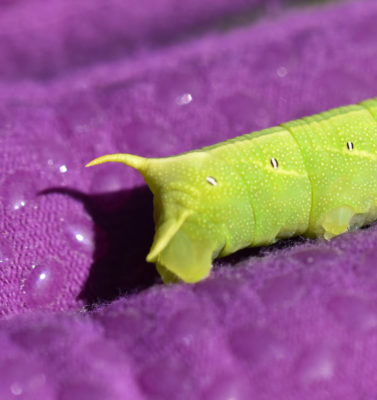
Many other Sphinx moths have coloured “horns.”
Both have a pale yellow line running from head to horn. And pale yellow lines beside the spiracles. And more importantly, to me, the spiracles are black with a white line dividing them in half. I have not yet found any other Sphinx caterpillars with that colour combination.
The range for Lettered Sphinx moths includes “southern Quebec and Ontario” and the larvae are supposed to “feed on Virginia Creeper, Wild Grape, and Pepper-Vine.” Those both fit my caterpillar.
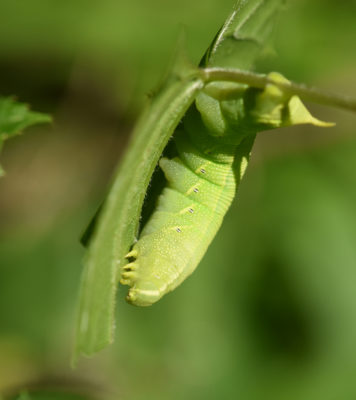
When I first met the caterpillar it was eating steadily.
While I have no idea what a Pepper-Vine is, there certainly are lots of Riverbank Grape and Creeper vines in Riverwood. (The type of Creeper is subject to some debate: it could be “Thicket Creeper” not “Virginia Creeper” according to some info I’ve read.)
I still can’t be sure it was a Lettered Sphinx moth caterpillar but I did find some more very promising evidence: the person at Riverwood who is voluntarily cataloguing all of the insect life reported an adult Lettered Sphinx Moth in May 2015.
Ta da! Once more the power of the internet is successfully used for good and the pursuit of knowledge!
(I’ll try to get confirmation of my id from either the BAMONA website or BugGuide but I’m confident enough to go ahead and share this today.)
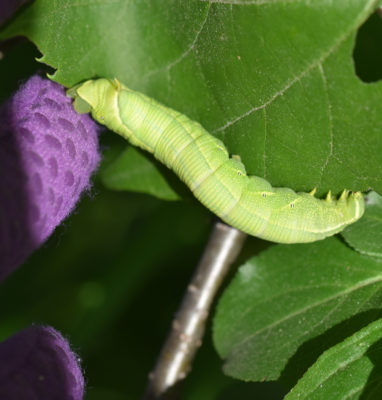
Of course I brought the caterpillar back to its leaf and waited till it walked off me.
How Big Are Lettered Sphinx and Pandora Sphinx Moths?
Looking at these huge caterpillars I wondered just how large the adult moths are. After all, these caterpillars are much larger than the more familiar full-grown Monarch caterpillars.
Lettered Sphinx moths are reported to have a wingspan of 42-70 mm. (1.7 – 2.75 inches.)
Pandora Sphinx moths can have a wingspan of 87 – 115 mm. Yes, that’s 3.4 – 4.5 inches.
Monarchs, for comparison, range from 86 – 105 mm according to BugGuide.
I’m not sure why the Sphinx caterpillars are so much “heavier” than the Monarchs, but I suspect it may be due to their life cycle. These two types of Sphinx moths both have to survive the winter and the cold temperatures of spring after they emerge before they can lay their eggs the following year. Perhaps Monarchs don’t need to store as much weight in advance as they feed steadily while moving south and north again? I’m just guessing but it might be interesting to know more about the energy needs of these two different types of creatures. I guess that’s another mystery to try to puzzle out in the future.
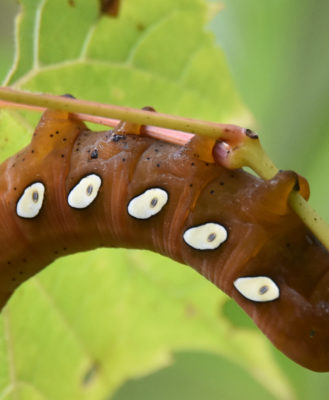
It’s worth trying to “spot” another eye-catching beauty like this!
In the meantime, I’ll have to keep my eyes open on our bird walks—I know there are other types of Sphinx moths at Riverwood which means there are more caterpillars out there waiting to be found!
Related Reading
- The Most Commonly Seen Huge Sphinx Caterpillars: Tobacco Hornworms and Tomato Hornworms
- Pretty good photos of the Lettered Sphinx Caterpillars showing the black circle with white line spiracles. (much better than mine!)
- Almost an exact match for the one I saw is on BugGuide.net at this page. Main page on the Lettered Sphinx
- What Is This Huge Green Caterpillar Crossing the County Road in Ontario?
- What Is This Spiky Orange and Black and White Caterpillar
Join In
Have you found a huge Sphinx caterpillar? Were you able to tell what kind it was? Please share your sighting with a comment.

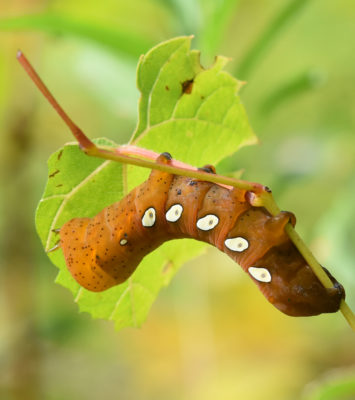
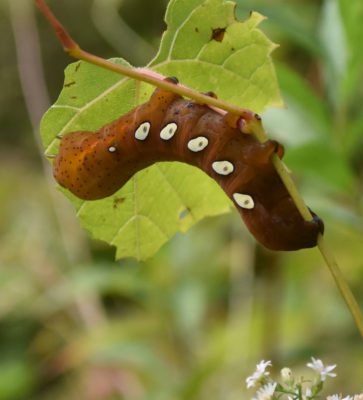
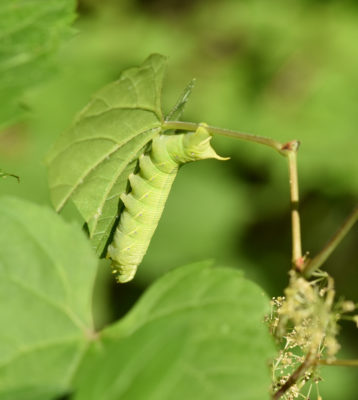
Found a Pandora sphinx caterpillar today – feeding on Va. Creeper. I’ve been seeing lots of sphinx moths on moon vine flowers and mimosa blooms every evening. Mid-August in southwest Missouri.
Great find! Thanks for sharing it.
Deb Bird, August 24/22
Found a Pandora Sphinx hanging on a grape vine laying over a globe cedar near our pool with my grandson. Came in to look it up.
That’s a great find!
Found this one on a stump in the yard!
Found two today. One green and one rusty. Both on grape vine. Northumberland Ontario. Thanks to your post I ID’d them.
The Pandora is one of the most common sphinx caterpillars but there are others. If you want to confirm your id you may want to post a photo to either iNaturalist or BugGuide.net. It’s likely they were Pandoras if the “spots” match.
I think what I just found is a Pandora spinx moth caterpillar. He was clinging to stick which was on the concrete piece under our downspout. I moved him to a better location!
Great rescue–thanks for sharing!
I found one in Alabama NY over the weekend hanging on a pine tree .
Sounds like it may be ready to pupate. Thanks for sharing!
Southeast Missouri, found a large dark orange color with 8 cream colored spots outlined in black. About five inches long.
At that size it must be ready to pupate!
Just found a Pandora Sphinx caterpillar in a Vineyard at 3200 feet in Black Mountain North Carolina.
Thanks for sharing your elevated sighting!
Found a rusty orange Caterpillar climbing on vines on a chain link fence in Stafford Connecticut yesterday with my six year old. First one I’ve ever seen.
They must be fairly common but I’ve almost never seen them too: surprising when they get so large!
I found the pandora Sphinx on my Virginia creeper. I live in Ottawa, Ontario.
I’m removing it so it doesn’t have babies and infest my vines…
Sorry to hear the Sphinx was causing enough damage to remove it–usually the vines don’t show much damage from them. Because the moths are common and free-flying, you may get more caterpillars in future years.
Just found one this week in Northwestern Missouri on a creeping vine of some type. I’ve never seen such a large caterpillar before!
Sorry for my slow reply. Thanks for sharing your sighting! When they are close to changing into a moth they are very large indeed!
Pandora Sphinx Moth Caterpillar found on grapevine in Millbrooke (south of Peterborough) community garden. Beautiful insect.
2019/09/23
Lettered Sphinx Moth Caterpillar seen in Bethany (south of Peterborough) “walking” along a hiking path
Sorry for my slow reply. Thanks for sharing your sightings! I haven’t seen a Lettered Sphinx so you’ve made me jealous (in a good way)!
I found a brown one today. Had no idea what it was. It’s spewing dark green, transparent goo from its face. I’m NOT touching it. Must be a sort of defense. So cool though!
Yes, that does sound like some type of defence. I wouldn’t touch it either!
Found a huge brown one in my yard
I just found one. It’s October here in Kansas. Seems little late to be walking around my yard.
Yes, that does sound late! Hopefully it will overwinter as a pupa.
I have found 2 on the ground in my Oklahoma backyard in October. This last one I picked up to move from my chihuahua’s attention and it was softly chirping while I held it!
Very cool! Thank you for sharing this (and for saving it!)
2023.08.14 found one in my grape vine here in southern Nova Scotia Canada, Found your postings while looking for an ID. GOT IT!!! :-)
Sounds good!
Saw a Pandora Sphinx Moth Caterpillar today in my yard on a Virginia Creeper vine. I have never seen one before.
This one was brown. Wish I could post picture. I live in Dalton, GA.
Yes, sorry it is not possible to add photos here. There is an interesting website called
iNaturalist.org
that lets everyone post their photos, though, if you are interested!
I have found the first one I’ve ever seen! And because of your description I know it’s a Pandora because it is on Virginia Creeper. Such a sight to see. Huge! Do they winter in the ground and come out in Spring? Near Peterborough Ontario.
If the season is too short for 2 broods, then they overwinter as pupae underground. In parts of New York state, the first batch hatches out and becomes moths during the same year they hatched from eggs, and the second brood over-winters. I’m not sure what our Ontario ones do!
Yesterday while taking photos of butterflies all over my blooming, shoulder high mint I spotted the brown caterpillar in my goosberry bush, where it was attached to a sneaky V. Creeper tht I had eradicated…I thought. I live in Nova Scotia on the Aspatogan Peninsula, a gorgeous place with the Seine Berth right behind me and the Atlantic 5min walk below me. Also thrilled to see a snake yesterday as i trimmed my highly producing wild blackberry bushes. A nice sized garter. Last week at one of my other properties I found a tiny baby one while moving logs to the splitter. Not seeing as many snakes as I’d like the last 3 yrs. especially the lovely lime green tree snakes. Earwigs and deer ticks howerver are too abundant. Sept. 14 2024
I’d love to see your property–it sounds wonderful! Thank you so much for sharing your sightings. I’m sorry I was unable to reply until today.